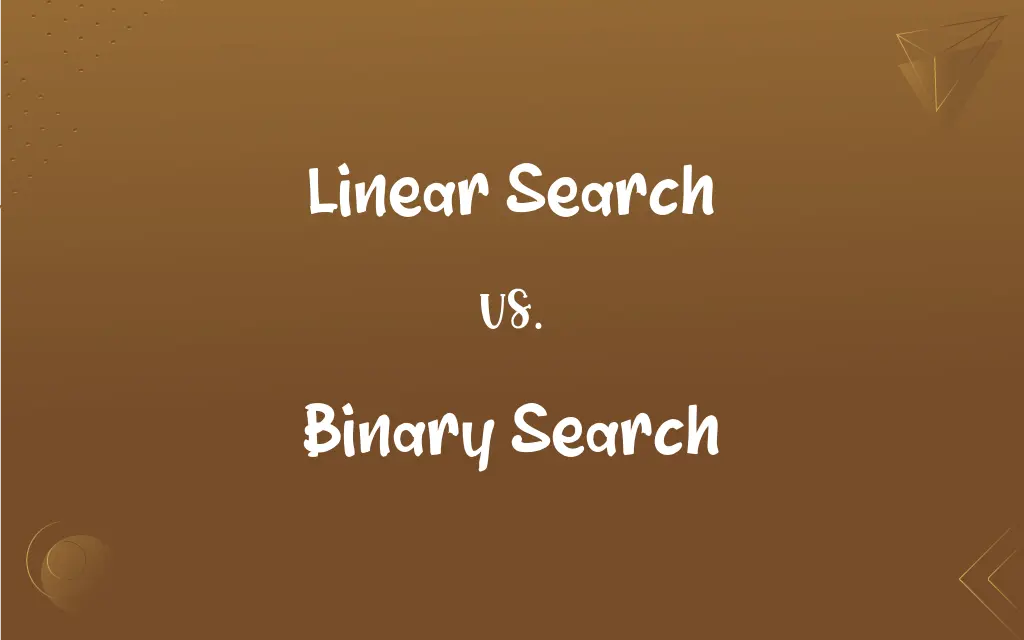Linear Search vs. Binary Search: What's the Difference?
By Janet White || Published on February 12, 2024
Linear search checks each element in a list sequentially, suitable for unsorted data; binary search divides and conquers sorted lists, rapidly narrowing the search area.

Key Differences
Linear search is a straightforward method that checks every element in a list one by one until it finds the target. Binary search, on the other hand, is more efficient on sorted lists, as it repeatedly divides the list in half to locate the item.
Linear search does not require the list to be sorted, making it versatile for any dataset. Binary search necessitates a sorted list to function correctly, as it relies on the order of elements to eliminate half of the remaining items each step.
In linear search, the best case is finding the item at the start of the list, and the worst case is at the end or not at all. For binary search, the best case is finding the item in the middle, and the worst case involves reaching the end of the division process.
Linear search's performance degrades linearly with the size of the list, making it less suitable for large datasets. Binary search excels in large, sorted datasets as its divide-and-conquer approach significantly reduces the number of comparisons.
Implementing linear search is simple and straightforward, requiring minimal coding. Binary search, while more complex to implement, offers greater efficiency and is preferred in scenarios where list sorting is feasible.
ADVERTISEMENT
Comparison Chart
Requirement of Sorted Data
Not required.
Required.
Search Method
Sequentially checks each element.
Divides list in half, then focuses on relevant half.
Performance in Large Lists
Slower as it checks each item.
Faster due to reduced comparisons.
Best Case Scenario
Finds target at the beginning of the list.
Finds target in the middle of the list.
Implementation Complexity
Simple and straightforward.
More complex, requires sorted list.
ADVERTISEMENT
Linear Search and Binary Search Definitions
Linear Search
It is a simple, brute-force search method.
Linear search methodically examined each entry in a diary to find a particular date.
Binary Search
It uses a divide-and-conquer approach for searching.
Binary search was used to find a movie title in an alphabetically sorted list.
Linear Search
Linear search operates regardless of the list's order.
Linear search was applied to find a contact in an unorganized phone list.
Binary Search
It repeatedly narrows down the search area by half.
To find a specific number, binary search divided the sorted list of numbers in halves.
Linear Search
Linear search scans each item in a list sequentially until it finds the target.
A linear search was used to find a student's name in an unsorted class list.
Binary Search
Binary search excels in large, sorted datasets.
To locate a product code, binary search split the sorted inventory list effectively.
Linear Search
Linear search is effective for small or unsorted datasets.
To find a specific tool in a toolbox, linear search examined each item one by one.
Binary Search
Binary search divides a sorted list into halves to find the target efficiently.
Binary search quickly located a word in a dictionary by splitting the pages.
Linear Search
It checks every element in the list, one after the other.
To locate a specific book, a linear search checked each book on the shelf in order.
Binary Search
Binary search requires the list to be in a sorted order.
In a sorted array of names, binary search efficiently found the desired name.
FAQs
Is linear search good for large datasets?
It's less efficient for large datasets due to its sequential nature.
What is binary search?
A search method that divides a sorted list in half repeatedly to find a specific element.
What is linear search?
A search algorithm that sequentially checks each element in a list until it finds the target.
How does binary search perform in large datasets?
It performs well in large datasets as it significantly reduces the number of comparisons.
Why does binary search need sorted data?
Because it relies on element order to efficiently divide and conquer the search space.
What is the complexity of binary search?
Its time complexity is O(log n), making it faster for larger lists.
Is linear search easy to implement?
Yes, it is straightforward and easy to implement.
Does linear search require sorted data?
No, linear search works on both sorted and unsorted data.
How does data size affect linear search?
As data size increases, linear search becomes slower due to more elements to check.
Can binary search be used on unsorted data?
No, binary search requires the data to be sorted for it to work correctly.
What are the disadvantages of binary search?
It requires sorted data and is more complex to implement than linear search.
Can linear search find multiple occurrences of an element?
Yes, it can find all occurrences by continuing the search even after a match is found.
Does binary search find the first occurrence of a duplicate element?
It finds an occurrence, but additional steps are needed to ensure it's the first occurrence.
Is binary search suitable for linked lists?
It's less suitable for linked lists due to the difficulty in accessing middle elements directly.
What happens if the element is not in the list in linear search?
Linear search will check every element and conclude the element is not present.
How does binary search react to an absent element?
It narrows down to a point where no elements are left to check, indicating absence.
Can linear search be optimized?
Its basic nature offers limited optimization, mostly in how elements are accessed.
Are there variations of binary search?
Yes, there are variations like iterative and recursive binary search.
What is the complexity of linear search?
Its time complexity is O(n), where n is the number of elements in the list.
Which is more commonly used, linear or binary search?
Binary search is more common in scenarios involving large, sorted datasets.
About Author
Written by
Janet WhiteJanet White has been an esteemed writer and blogger for Difference Wiki. Holding a Master's degree in Science and Medical Journalism from the prestigious Boston University, she has consistently demonstrated her expertise and passion for her field. When she's not immersed in her work, Janet relishes her time exercising, delving into a good book, and cherishing moments with friends and family.







































































